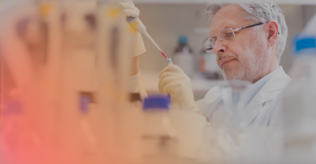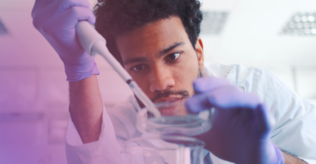Life Sciences innovations in the LGBTQIA+ community

Over the past 70 years, the life sciences industry has made significant progress in supporting the LGBTQIA+ community. From groundbreaking innovations in fertility treatments for same-sex couples to the development of drugs that prevent HIV, the industry has seen exciting advancements. However, there is still a long way to go and substantial strides are needed to improve support and care as well as ensuring there is greater equality and diversity in research, development, and clinical trials. To mark Pride Month, we explore some noteworthy healthcare innovations that actively transformed and support and care for the community.
HIV prevention and treatment:
One in six bisexual and gay men are at risk of an HIV diagnosis in their lifetime, making it a significant concern for those in the LGBTQIA+ community. The global pandemic of HIV/AIDS began when the first cases were reported in 1981, and to this day it remains a global public health issue, creating demand for new treatments and prevention interventions.
Since the 1980’s, advancements in treatment and prevention have greatly improved outcomes. Advocacy efforts from this community have been instrumental in ensuring access to treatment and improving quality of life for individuals with HIV.
One of the first notable milestones in HIV research was the case of Timothy Ray Brown. Known as the “Berlin patient”, Timothy was the first person to be cured of HIV. Brown was diagnosed with HIV in 1995 and 11 years later, underwent treatment for leukaemia. During his treatment, Dr. Huetter, a leading doctor in Berlin, had the idea of looking for a stem cell donor that carried a mutation of an HIV-related gene called CCR5. This mutated gene makes the blood cells effectively immune by blocking the attachment of HIV to the cell. Following a stem cell transplant, HIV was no longer found in Brown’s blood, a landmark discovery in the quest for a cure. This milestone has paved the way for further research, and similar treatments have cured others, marking significant progress in HIV research.
In 2012, there was a significant development in treatment when the FDA approved Pre-Exposure Prophylaxis (PrEP), a daily medication that helps prevent the spread of HIV by inhibiting the virus from entering cells and reproducing. Studies have demonstrated PrEP’s efficacy in reducing the risk of HIV infection by up to 99% when taken consistently. The iPrEx study, found that daily PrEP reduced the risk of HIV infection by 44% overall and by more than 90% among participants with detectable drug levels.
There have also been many advancements in antiretroviral therapy (ART) which have greatly improved the quality of life for those living with HIV. ART can suppress the viral load to undetectable levels, meaning the virus cannot be transmitted to others, a concept promoted by the UNAIDS campaign Undetectable=Untransmissible (U=U). Studies such as the PARTNER and HPTN 052 trials have provided significant evidence supporting U=U, showing that people with undetectable viral loads do not transmit the virus to their sexual partners. Despite these medical advancements, stigma surrounding HIV remains. The U=U campaign works to increase awareness and education about the transformative progress in HIV treatment, aiming to reduce stigma and improve the lives of those living with HIV.
Since the first US HIV vaccine trial by the National Institutes of Health (NIH) Clinical Centre in 1987, there has been a great deal of research into the treatment and prevention of HIV. In 2022, the National Institute of Allergy and Infectious Disease (NIAID) announced that an mRNA-based vaccine, which uses the same technology that was used in the Covid-19 vaccines, has begun its first human trials, which could potentially eradicate the spread of HIV. Other companies like Moderna, BioNTech, and Gilead Sciences have also been instrumental in advancing research and development efforts for HIV vaccines and treatments.Promising advancements at the CROI 2024 conference included successful trials of injectable HIV treatments and new once-weekly oral treatments. Studies on lenacapavir plus bnAbs and cabotegravir plus VRC07-523LS demonstrated successful outcomes in maintaining viral suppression, offering an effective alternative for individuals struggling with daily ART adherence.
3D printing for fertility
For same-sex couples, transgender and non-binary individuals, starting a family can require intervention. In recent years, the LGBTQIA+ community has witnessed incredible progress when it comes to fertility options. With incredible advancements in reproductive technology, individuals and couples from all sexual orientations and gender identities now have a range of options when it comes to having children.
Developments across life sciences from scientists and engineers, like Jemma Redmond, an award-winning scientist who co-founded a successful 3D bioprinting wanted to address fertility issues have been game changing for those struggling with their fertility. Fertility was topic close to Redmond’s heart, discovered she was intersex later in her life, which meant she was unable to conceive children. This was a core motivator in her research on developing 3D-printed organs in ways that made them accessible and affordable for everyone. Since then, there have been huge breakthroughs in the use of 3D printing technology. Back in 2017, scientists made a framework using gelatin, which is safe for the body. This framework had small holes to hold follicles, which are tiny sacs with immature eggs. When this framework filled with follicles was implanted into mice, it connected to the body's blood supply within a week. The follicles matured and released eggs naturally through the small holes in the framework, leading to healthy pregnancies and offspring. This shows promise for the future development of 3D bioprinting in healthcare and addressing fertility issues for all.
Hormone replacement therapy (HRT):
Hormone Replacement Therapy (HRT) is crucial for many transgender and non-binary individuals as part of their transition process. HRT can have profound physical and mental health benefits, often preceding gender-affirming surgeries.
Synthetic oestrogen first became available in 1938 but wasn’t used for transitional purposes until 1953 when Danish endocrinologist, Christian Hamburger, published the earliest known reports on hormone therapy. His patient, Christine Jorgensen, is often referred to as one of the first cases of gender reassignment in the US, where oestrogen-based medication was used as part of the successful transition. Testosterone became available in 1935 and was approved for medical use in 1939 and both hormones have continued to be developed and are used regularly in modern gender reassignment.
There are thousands of transgender people who are looking to transition but have limited access to affordable HRT that is safe to use at home. As we learn more about gender identity and see an increase in people globally who identify as transgender, the demand for hormone replacement therapy (HRT) gets higher. High demand has caused shortages, leading to patients having to wait upwards of 5 years to receive the hormone drugs as the industry continues to adapt to the growing need.
HRT medication has saved many lives and helped transgender people suffering from gender dysphoria, which can affect their mental health. Gender dysmorphia is a sense of unease that a person may have because of a mismatch between their biological sex and their gender identity. HRT and gender-affirming medical surgery are commonly used to treat this and have shown to cause significant improvement in the quality of life of a transgender person.
Recent breakthroughs in fertility technology, such as in vitro gametogenesis (IVG), offer hope and new possibilities for the LGBTQIA+ community. This technique, still in research, involves converting skin cells into viable eggs, allowing individuals who cannot produce their own eggs to have genetically related children.
More innovations to come…
The medical breakthroughs we've seen so far, such as PrEP, gender-affirming therapies, and tailored mental health services, have already made a significant difference in ensuring that the LGBTQIA+ community is being supported better. What's also exciting to see, are future advancements like the growth of precision medicine and telemedicine, which offer increased accessibility to healthcare for LGBTQIA+ individuals. Along with the fight for policy changes and advocacy, we're on track for fair and improved healthcare delivery.
It's also important to consider the representation of employees in life science organisations, bringing in diverse perspectives and a better understanding of the community's needs. It's crucial to ensure that we have more diverse clinical trials to finally get more accurate data and develop treatments that actually work for LGBTQIA+ individuals.
By embracing these changes and making sure everyone's voices are heard, the life sciences sector can truly make a positive impact on the well-being of the LGBTQIA+ community.
Found this blog interesting? Find out more about the latest healthcare trends by following us on LinkedIn and Youtube.






+(395+x+285+px).png)

+(395+x+285+px)+(1).png)
.png)



.png)


